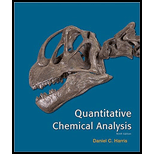
Concept explainers
(a)
Interpretation:
The
Concept introduction:
Molarity can be defined as the moles of solute (in grams) to the volume of the solution (in litres). The molarity of a solution can be given by the formula,
(a)
Answer to Problem 7.19P
The
Explanation of Solution
To calculate: The
Given,
The titration reaction of
Before equivalence point, more moles of oxalate ion present in solution than calcium ions. The strength of unprecipitated oxalate ion is calculated as
Total volume of both solution is
The concentration of iodide ion is
The concentration of silver ion which is in equilibrium with iodide ion is
(b)
Interpretation:
The
Concept introduction:
Molarity can be defined as the moles of solute (in grams) to the volume of the solution (in litres). The molarity of a solution can be given by the formula,
(b)
Answer to Problem 7.19P
The
Explanation of Solution
To calculate: The
Given,
The titration reaction of
At equivalence point, moles of oxalate present in solution is equal to calcium ions.
The concentration of silver ion and iodide ion is calculated as
(c)
Interpretation:
The
Concept introduction:
Molarity can be defined as the moles of solute (in grams) to the volume of the solution (in litres). The molarity of a solution can be given by the formula,
(c)
Answer to Problem 7.19P
The
Explanation of Solution
To calculate: The
Given,
The titration reaction of
The volume of calcium ions at equivalence point is
Most of oxalate ion are precipitated at equivalence point. After equivalence point, more moles of calcium ions present in solution. The volume of calcium ion after equivalence point is
Want to see more full solutions like this?
Chapter 7 Solutions
QUANTITATIVE CHEM ANALYSIS CUSTOM 9TH
 ChemistryChemistryISBN:9781305957404Author:Steven S. Zumdahl, Susan A. Zumdahl, Donald J. DeCostePublisher:Cengage Learning
ChemistryChemistryISBN:9781305957404Author:Steven S. Zumdahl, Susan A. Zumdahl, Donald J. DeCostePublisher:Cengage Learning ChemistryChemistryISBN:9781259911156Author:Raymond Chang Dr., Jason Overby ProfessorPublisher:McGraw-Hill Education
ChemistryChemistryISBN:9781259911156Author:Raymond Chang Dr., Jason Overby ProfessorPublisher:McGraw-Hill Education Principles of Instrumental AnalysisChemistryISBN:9781305577213Author:Douglas A. Skoog, F. James Holler, Stanley R. CrouchPublisher:Cengage Learning
Principles of Instrumental AnalysisChemistryISBN:9781305577213Author:Douglas A. Skoog, F. James Holler, Stanley R. CrouchPublisher:Cengage Learning Organic ChemistryChemistryISBN:9780078021558Author:Janice Gorzynski Smith Dr.Publisher:McGraw-Hill Education
Organic ChemistryChemistryISBN:9780078021558Author:Janice Gorzynski Smith Dr.Publisher:McGraw-Hill Education Chemistry: Principles and ReactionsChemistryISBN:9781305079373Author:William L. Masterton, Cecile N. HurleyPublisher:Cengage Learning
Chemistry: Principles and ReactionsChemistryISBN:9781305079373Author:William L. Masterton, Cecile N. HurleyPublisher:Cengage Learning Elementary Principles of Chemical Processes, Bind...ChemistryISBN:9781118431221Author:Richard M. Felder, Ronald W. Rousseau, Lisa G. BullardPublisher:WILEY
Elementary Principles of Chemical Processes, Bind...ChemistryISBN:9781118431221Author:Richard M. Felder, Ronald W. Rousseau, Lisa G. BullardPublisher:WILEY





